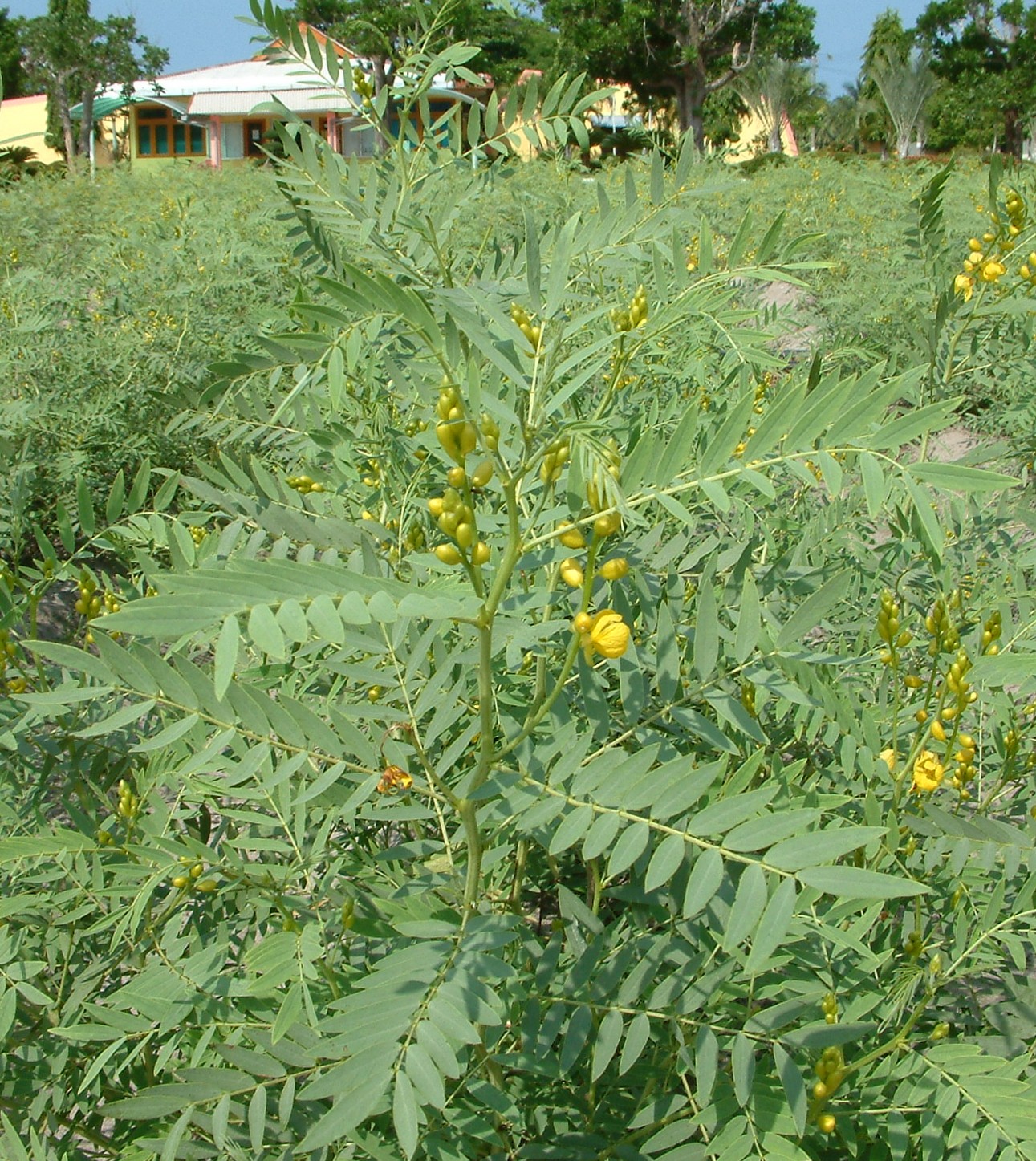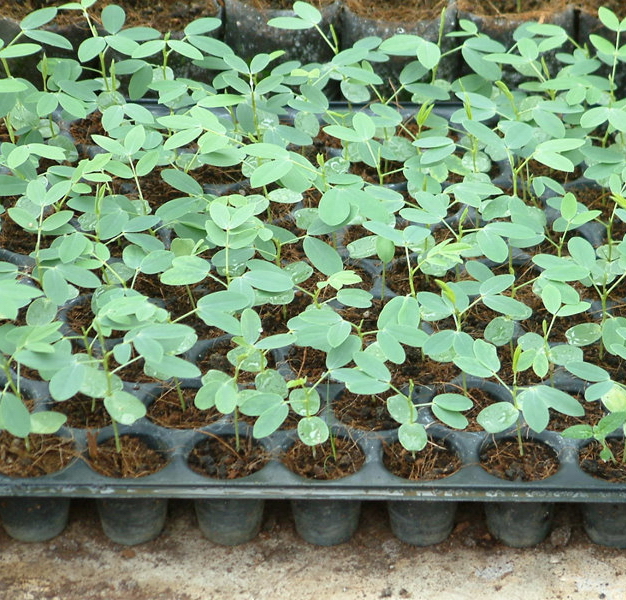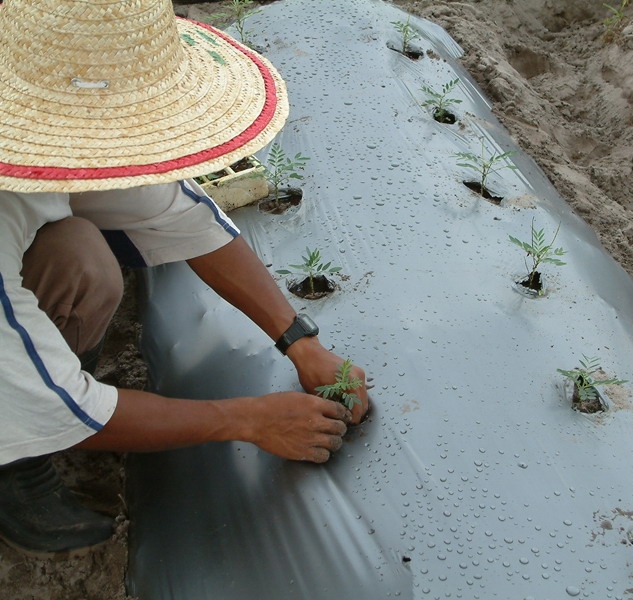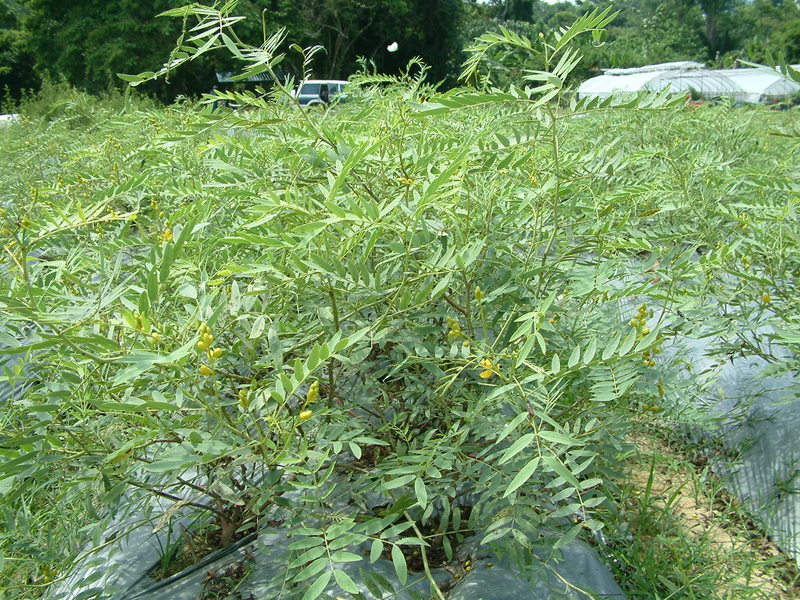Botanical Names
Cassia angustifolia Vahl
Common Names
| Malaysia | Senna mekah. |
| English | Mecca senna, Tinnevally senna. |
| Thailand | Makham khaek. |
| India | Nilavarai, nelavakai. |
| China | Fan xia ye. |
Family
Leguminosae

Introduction
’Senna mekah’ is native to Yemen. The plant is commercially grown in Southern India especially in Tamil Nadu dan Gujarat. This plant has potential to be grown under our local condition. With good agricultural practices, this plant is able to produce 7-8 t/ha of fresh leaf yield.[1]
Morphological Features
The plant is an annual crop and can grow up to 60-100 cm tall. The stem is woody, branching profusely and of light green. The leaf is pinnate with several leaflets. The flower bud appears at about 40 days after transplanting and reaches full bloom at about 65 days. The flower is bright yellow. The seed pod becomes visible at about 75 days after transplanting. The pod is thin, slender and soft with an average length of 3.5-6.5 cm and width of 1.5-2.0 cm. As the pod matures, the pod colour changes from green to greenish-brown, to dark brown and black. Under local condition, each seed pod contains 5-8 seeds.[1]

Medicinal Properties and Usage
The parts used in traditional medicine are the leaf and seed pod. The leaf and seed pod contains anthraquinone glucoside (sennocide), carthartic acid, myricyl alcohol, calcium salt, isohamnentin, rhein anthrone, aloe-emodin glycoside, kampferol dan isormamnetin. The leaf itself contains 2.9-3.9% sennoside and the seed pod contains 3.5-4.0% sennoside. The leaf and seed pod are normally used for treating skin disorders, constipation, anaemia, typhoid, cholera, bronchitis, cough, gout, rheumatism and jaundice.[1][2][3][4]
Soil Suitability and Climatic Requirement
‘Senna mekah’ is suitable for planting on sandy loam and clay loam soils. Sandy soils such as bris can also be planted with ‘senna mekah’. This plant is sensitive to stagnant water, heavy rain and low temperature conditions. The plant performs well under full sunlight thus suitable for drier areas or short rainfall season. Average monthly rainfall about 25-40 cm is adequate for satisfactory growth of ‘senna mekah’.[1]
Field Preparation
Land Preparation
Good land preparation is very important for good control of weeds and crop establishment. The planting area has to be ploughed once with a disc plough followed twice using a rotovator.[1]
Production of Planting Materials
The planting of ‘senna mekah’ can be done by seeding directly into the planting hole in the field. About 6 kg of seeds is sufficient for one hectare of planting area. The seed treatment such as hot water treatment is recommended, to improve germination percentage, as the seed coat is thick and hard. Normally, the ‘senna mekah’ seeds start to germinate 4-5 days after sowing and can be transferred into polybags or plastic trays when reaching the 2-3 leaf stage.[1][5]

Field Planting
The soil should be ploughed twice before planting to provide a suitable growing condition. The planting distance recommended is 45-50 cm between rows and 30 cm between plants, which gives a population density of 66,700-74,100 plants/ha. Planting during rainy season is not recommended to avoid heavy infestation of fungal diseases on stem and roots.[1][6]


Field Maintenance
Fertilisation
The recommended fertiliser rate is 80, 30 and 20 kg/ha of N, P2O5 and K2O respectively. Compound fertiliser 15:15:15 at the rate of 30 kg/ha is 10-15 days after transplanting. Urea (46% N) at 25 kg/ha is applied immediately after each harvest at about 55 and 95 days afer transplanting. Urea is broadcasted 4-5 cm under the plant canopy. Fertigation can also be done at the same rate as applied in the manual method. The fertigation frequency is 20-30 times throughout the crop growth.[1]
Weed Control
Manual control of weeds in the planting area especially at 25-30 and 75-80 days after transplanting helps in promoting better growth and yield of this plant. Plastic mulching can also provide good control of weeds provided suitable irrigation system is used, such as drip.[1]
Water Management
The plant requires adequate amount of water for normal growth especially at the beginning of the planting season. Irrigation is also required after every harvest to promote the growth of new shoots, especially in hot season. The amount of irrigation water should be reduced after the fruit has been formed to minimise the fruit from being infested with fungus disease. If drip system is used for irrigation, the frequency should be maintained at 3 times a week throughout the growth period.[1]
Pest and Disease Control
Damping-off is the major disease during the seedling stage. This disease spreads easily under wet/damp condition. The problem can be solved if by practising good sanitary practices. Major pest for this plant is leaf eating caterpillar Pieris sp., which normally feeds on the young leaf. This pest can be controlled using Bacillus thuringiensis.[1]
Harvesting
The leaves are harvested 3 times within the 140-150 days period for each planting. The harvesting is done manually using secateurs. The first harvest is 55-65 days (alluvial soil) and 70-85 days (bris sandy soil) after transplanting. The harvest is repeated with an interval of 30-40 days after the prior harvest. About 7-8 t/ha of fresh leaf yield is obtained from the three harvests. This will turn to 1.4 t/ha of dry leaf yield.[1]
Postharvest Handling
To obtain a good quality of dried raw material, the harvested leaves should be uniformly distributed in an open area for about 6-10 hours to reduce the moisture. The leaves are then dried for 3-5 days under a well ventilated shade structure until it reaches a moisture content of 10%. The leaves can be dried faster using mechanical method at temperature not exceeding 40oC. The use of low drying temperature is to ensure the bioactive content remains. The dried leaf should be stored in a dry cold room. This method of storage can retain the quality of the raw material for 1-3 years.[1]
Estimated Cost Of Production
Based upon 3 harvests, average production cost per hectare for ‘senna mekah’ is RM5,770 per season. At a yield level of 1.4 t/ha, the estimated cost of ‘senna mekah’ leaf is about RM4.12/kg. The production cost was estimated based on the cost of current inputs during writing of this article.[1]
Read More
References
- Omar, T., Ahmad Puat, N., Wan Zaki, W.M. and Yahaya, H. (2005). Senna mekah. In: Penanaman tumbuhan ubatan dan beraroma. (Musa, Y., Muhammad Ghawas, M. and Mansor, P., ed.). Pg. 83-89.Serdang: MARDI
- Anon. 2002. Compendium of Medicinal Plants Used in Malaysia (Vol. 1) Pg 151, HMRC-IMR
- Singh, M., Chandhuri, P.K. and Sharma, R.P. (1995). Constituents of the leaves of Cassia angustifolia. Fitoterapia. 66(3):284.
- Kinjo, J., Ikeda, T., Watanabe, K. and Nohara, J. (1994). An anhraquinone glucoside from Cassia angustifolia. Phytochemistry. 37(6):1685-1687.
- Wan Zaki, W.M. (2004). Development of seedling production technique for senna makki (Cassia angustifolia). Pemantauan Projek Herba Pusat Penyelidikan Padi dan Tanaman Industri, 21-23th April 2004, Pusat PPPL, UPM, Serdang, Selangor. Organiser: MARDI.
- Wan Zaki, W.M. (2004). Determination of optimum planting distance for senna makki (Cassia angustifolia). Pemantauan Projek Herba Pusat Penyelidikan Padi dan Tanaman Industri, 21-23th April 2004, Pusat PPPL, UPM, Serdang, Selangor. Organiser: MARDI.

